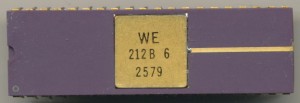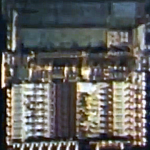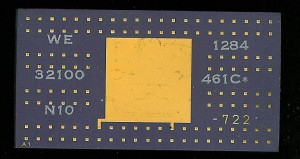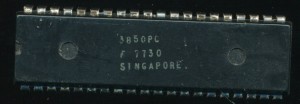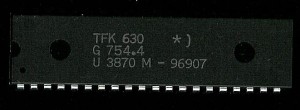CPU of the Day: Bell Labs BELLMAC-8 aka the WE212
Many great technologies have came out of Bell Labs including the C programming language and UNIX. Bell Labs was the R&D arm of AT&T and developed most everything in house for AT&T. Bell was loathe to use any product that was not their own, so when the computing age of the 70s came, it was only natural for them to develop an in-house microprocessor to run their telecom systems.
The first processor Bell developed was the BELLMAC-8 in 1977. The BELLMAC-8 was a fairly simple 8-bit processor containing over 7000 transistors and made on a 5 micron CMOS process. It ran at up to 2 MHz at 5V (5V and -5V supplies). It implemented 40 instructions most taking around 4 cycles to complete. the MAC-8 used a 8-bit data bus and a 16-bit address bus (capable of addressing up to 64 Kbytes of RAM). The BELLMAC-8 is a register based design
with 16 general purpose 16-bit registers. These registers are stored off chip in memory and an on chip Register pointer register (rp) contains the address of their beginning location in memory. One could perform register ‘saves’ for IRQ handling by simply changing the value in the register pointer register (and storing the old value on the stack).
There is not a great amount of information on the BELLMAC-8 as it was intended for use within Bell/AT&T. It was not designed or intended to be a commercial processor. It was used (and branded) be Western Electric (which was the production arm of AT&T) in many telecom products. Despite its wide use, very little documentation exists, at least outside of AT&T. It is not a processor covered in any of the standard books/catalogs (such as IC Master, Osborne or other period microprocessor selection guides), most likely because it was for Bells use exclusively. There was a trainer system made for the BELLMAC-8 used to teach engineers how to use the processor. Most produced BELLMAC-8s are labeled as WE212 (or F-60789 on the trainers) and are found in Western Electric products. The WE212 came in several 40-pin packages, including a version with a gold lid, and a version with a black ceramic lid. Western Electric made several versions (though no documentation on the differences). These included both the WE212C and the WE212B.
In 1979 Bell released the BELLMAC-4, a microcomputer version of the BELLMAC-8 containing on chip ROM and RAM. It was made on a 3.5 micron process. In 1980 Bell announced the BELLMAC-80. The BELLMAC-80 was made on a 2.5 micron process (using domino logic CMOS) and contained over 150,000 transistors. It was Bell’s first 32 bit processor (completely skipping over 16 bit designs) and was later renamed the BELLMAC-32. A product improved version was called the BELLMAC-32A. Better known as the 32100 and 32200 processors these CPU’s were used well into the 1990’s. Unlike the mysterious BELLMAC-8 there is some documentation and wider use of the 32100 series of processors.
Tags:
BELLMAC, WE212, Western Electric
Posted in:
CPU of the Day


